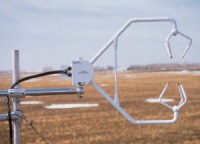Table of Contents
Sonic Anemometer
Description
Cost
Purchase: Not given. Similar instruments cost ~ $2400
Maintenance: Negligible. Only regular maintenance would be replacing transducer wicks.
Calibration: Negligible.
Operating Physics
The main principle of a sonic anemometer is that the velocity of a sound wave in a moving medium is equal to the sum of the speed of sound and the velocity of the medium. However, the speed of sound in a fluid is dependent on the fluid's density. In the atmosphere, this means that the speed of sound is dependent on the temperature and moisture of the air.
In the CSAT3, three sets of transducers are aligned non-orthogonally to one another (Figure 1). An ultrasonic impulse is sent between the transducer pairs. The time it takes the pulse to move between the transducer pairs is measured. This is called the time of flight. Next, the wind speed along the transducer axis (ua) is determined from the difference in the time of flight out (to) and the time of flight back (tb) along with the distance between the transducers (d).

Once each set of transducers has determined a wind speed along their axes, these wind speeds are converted into the u, v, and w components by multiplying the measured wind speeds by a 3 x 3 coordination transformation matrix.
The CSAT3 makes a measurement when triggered by either the internal trigger or by an external trigger via a communication device. If the unit is set to make measurements based on it's internal trigger, it will continue to take measurements at this rate until the value is changed. The overall power consumption of the unit is dependent on the trigger rate (Figure 2).
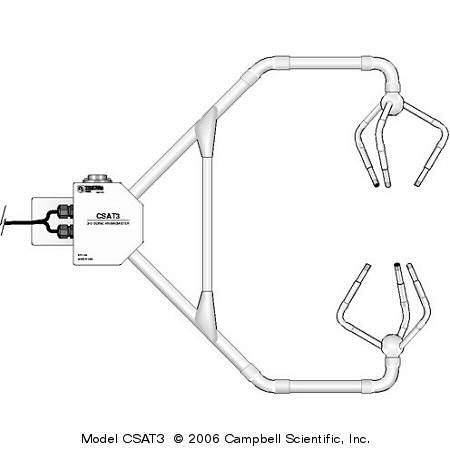
Figure 1. Overview of the CSAT3 Sonic Anemometer
Performance
Measurement Rate
1-60 Hz
Resolution
u and v component: 1 mm s-1
w component: 0.5 mm s-1
speed of sound: 15 mm s-1
Operating Range
-30 to 50 C (standard)
-40 to 40 C (cold shifted)
Error (wind speeds < 30 ms-1)
u and v component < 4 cm s-1
w component < 2 cm s-1
Power Requirements
Voltage: 10-16 V
Power: 2.4 W @ 60 Hz, 1.2 W @ 20 Hz
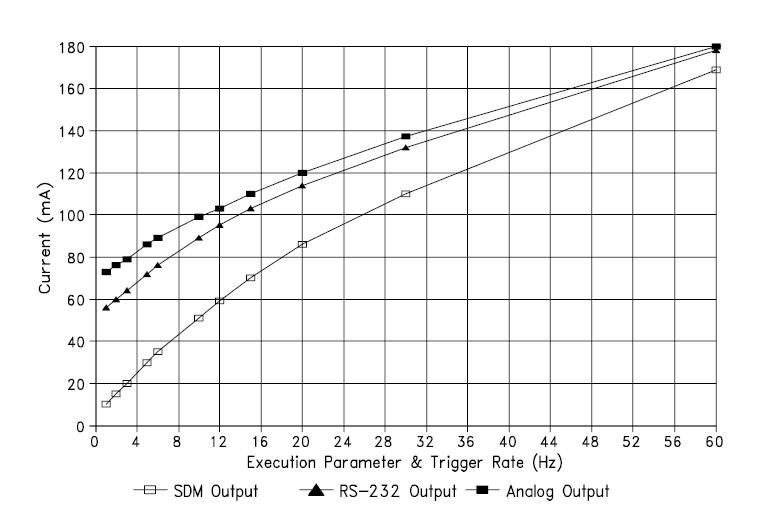
Figure 2: CSAT3 power requirements as a function of sampling frequency.
Field Projects
Two examples of field projects utilizing the CSAT3 are given below.
- Monitoring greenhouse gas fluxes over Korean rice paddies during the summer of 1999.
- Retrieval of canopy turbulence profiles in and above Mediterranean tree crops (Figure 3).
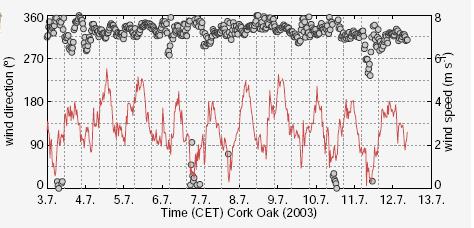
Figure 3: Example of data obtained from the Meditteranean turbulence study (Vogt et al. 2006).
Specifications
Physical Description:
Measurement Path Length:
10.0 cm vertical; 5.8 cm horizontal
Path Angle from Horizontal: 60 degrees
Transducer: 0.64 cm diameter
Transducer Mounting Arms: 0.84 cm diameter
Support Arms: 1.59 cm diameter
Dimensions:
Anemometer head:
47.3 cm (l) x 42.4 cm (h)
Electronics box:
26 cm x 16 cm x 9 cm
Weight:
Anemometer head: 1.7 kg (3.7 lb)
Electronics box: 3.8 kg (8.4 lb)
Documentation
Campbell Scientific's website for the CSAT3 can be found here. http://www.campbellsci.com/csat3
Calibration
Method
The CSAT3 is calibrated over the range of -30 to 50 C for standard mode or -40 to 40 C for cold shifted mode. The CSAT3 may or may not make measurements outside of this range, and any measurements taken outside of this range will be suspect. The CSAT3 does not require any field calibrations.
The unit will require calibration when the wind offsets are greater than the manufacturer's specifications, or it will set diagnostic flags under dry conditions with little to no wind and minimal obstruction. It is best to calibrate the instrument in a lab, since an environment with zero wind will be needed. Calibration can be performed by placing a medium sized, 13 gallon garbage bag over the instrument head. Perform measurements at a frequency of 1 Hz to minimize ultrasonic reflections off of the bag. The supplied CAT3 support software will aid in calibration, and determine if the wind offsets are within the bounds established by the manufacturer.
Sources of Error
One of the most problematic sources of error arises when the transducer pairs are obstructed or partially obstructed. If rain drops come in contact with the tip of the transducers, the sonic signal will be scattered and the wind measurements will be erroneous. Wicks can be placed on the transducer faces to help absorb any raindrops that may come in contact with the instrument. However, the wicks will only be useful in summer months. In the winter, snow and ice can accumulate on the wicks. During these months, manually cleaning of the transducer face with a cotton swab or tissue is required.
Another source of error that should be considered is the effect of a cross wind on measurements. This error however does not need to be corrected by the user, as the CSAT3 has a built in algorithm to correct for this effect based on the work of Liu et al. (2001). The CSAT3 is the only commercially available sonic anemometer that offers a correction for the effects of a cross wind.
Exposure Requirements
The unit should be set up such that the anemometer is aligned with the prevailing winds. This will help reduce obstruction errors from the unit's arms. Also, precipitation particles contacting the transducers will cause errors in measurements. For this reason, one may consider placing the unit under some sort of canopy. However, this will cause a disruption in the fluid flow, and could effect wind and turbulence fluctuation measurements.
Deployment
Measurement Methods
The CSAT3 can measure the following items:
- average horizontal wind speed
- average horizontal wind direction
- turbulent fluctuations of horizontal and vertical wind
- horizontal and vertical momentum flux
- sensible and latent heat fluxes
Sampling Modes
Single Measurement Mode
In this measurement mode, the CSAT3 makes one measurement per trigger. The downfall of this approach is that high frequency signals are aliased to lower frequencies.
Oversample Mode
Several measurements are taken for each trigger. The measurements are averaged together and output at the trigger rate.
Deployment Platforms
Communication
The CSAT3 has three ouput signals: SDM, RS-232 (serial), and analog. SDM is a Campbell Scientific communication protocol used between a Campbell Scientific datalogger and a sensor. It is recommended that SDM be used whenever possible because it offers the lowest current drain, best control and diagnostics, and highest data resolution of the three options.
Power and Installation
The CSAT3 should be installed such that it points towards the prevailing wind. This technique will help minimize contamination errors from the arms of the instrument as well as other supporting structures. The unit is mounted on top of a tripod constructed of 3/4“ diameter pipe, with the systems electronics box attached to the base of the tripod.
The CSAT3 has a bubble level on the anemometer head to aid in leveling the instrument. On level terrain, the bubble level should read such that the bubble is centered within the bullseye. On sloped terrain the anemometer head should be aligned such that the horizontal surface the bubble level is mounted on is parallel to the terrain.
System Automation
The CSAT3 is designed to support automation. As mentioned previously, the trigger that determines when measurements will be taken will continue to operate until it is re-set to another value. In addition, the CSAT3 supports an assortment of dataloggers. Table 1 lists the SDM compatible dataloggers available for use with the CSAT3.
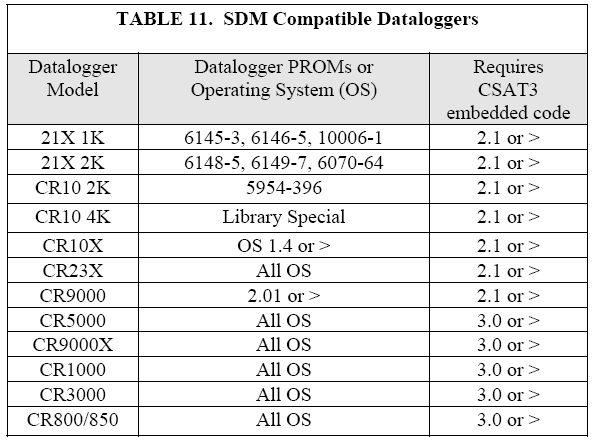
Table 1: SDM compatible dataloggers.
Data
Quality Control
The CSAT3 has a built in algorithm that corrects for the effects of crosswinds on the wind measurements. This topic has been previously disussed in the Sources of Error section.
Quality Assurance
Some quality assurance measures that may need to be taken with the CSAT3 would be to remove data collected during precipitation events, as the precipitation would interfere with the ultrasonic signal. Some of the data collected immediately following a precipitation event may also be suspect since condensation may have collected on the transducer heads. In addition, missing data might arise from power outages.
References
http://www.campbellsci.com/csat3
Liu, H., Peters, G., and Foken, T.: 2001, “New Equations for Sonic Temperature Variance and Buoyancy Heat Flux with an Omnidirectional Sonic Anemometer”, Boundary-Layer Meteorol., 100, 459-468.
www.atm.helsinki.fi/ILEAPS/fluxworkshop2006/presentations/13_Vogt_protected_new.pdf
